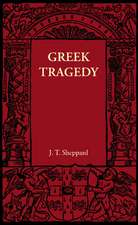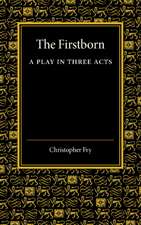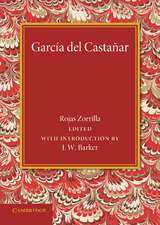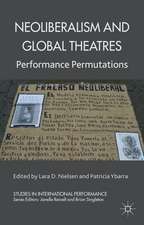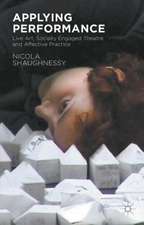A History of Japanese Theatre
Editat de Jonah Salzen Limba Engleză Paperback – 4 iul 2018
| Toate formatele și edițiile | Preț | Express |
|---|---|---|
| Paperback (1) | 341.84 lei 6-8 săpt. | |
| Cambridge University Press – 4 iul 2018 | 341.84 lei 6-8 săpt. | |
| Hardback (1) | 949.61 lei 6-8 săpt. | |
| Cambridge University Press – 13 iul 2016 | 949.61 lei 6-8 săpt. |
Preț: 341.84 lei
Nou
Puncte Express: 513
Preț estimativ în valută:
65.42€ • 68.05$ • 54.01£
65.42€ • 68.05$ • 54.01£
Carte tipărită la comandă
Livrare economică 14-28 aprilie
Preluare comenzi: 021 569.72.76
Specificații
ISBN-13: 9781108458160
ISBN-10: 1108458165
Pagini: 592
Ilustrații: 69 b/w illus. 4 tables
Dimensiuni: 203 x 253 x 32 mm
Greutate: 1.16 kg
Editura: Cambridge University Press
Colecția Cambridge University Press
Locul publicării:Cambridge, United Kingdom
ISBN-10: 1108458165
Pagini: 592
Ilustrații: 69 b/w illus. 4 tables
Dimensiuni: 203 x 253 x 32 mm
Greutate: 1.16 kg
Editura: Cambridge University Press
Colecția Cambridge University Press
Locul publicării:Cambridge, United Kingdom
Cuprins
Foreword James R. Brandon; Timeline Rachel Payne; Editor's introduction Jonah Salz; Part I. Traditional Theatres: Preface to Part I Laurence Kominz; 1. Ancient and early medieval performing arts Terauchi Naoko; Interlude: katari narrative traditions: from storytelling to theatre Alison Tokita; 2. Noh and Muromachi culture Shinko Kagaya and Miura Hiroko; Interlude: noh and kyogen costumes and masks Monica Bethe; 3. Kyogen: classical comedy Jonah Salz; Interlude: iemoto: the family head system Eric C. Rath; 4. Kabuki: superheroes and femmes fatales Julie Iezzi; Interlude: nihonbuyô: classical dance Paul Griffith and Okada Mariko; Interlude: Okinawan theatre: boundary of Japanese theatre Suzuki Masae; 5. Bunraku: puppet theatre Goto Shizuo; Interlude: misemono and rakugo: sideshows and storytelling Matthew W. Shores; Interlude: kamigata geinō: Kyoto-Osaka style Gondo Yoshikazu; Interlude: traditional theatre tomorrow: interview with Takemoto Mikio Shinko Kagaya; Part II. Modern Theatres: Preface to Part II Brian Powell; 6. Birth of modern theatre: Shimpa and shingeki Brian Powell; Interlude: new comedy, Asakusa opera, OSK musicals Nakano Masaaki; Interlude: Takarazuka: all-girls' revue and musicals Yamanashi Makiko; 7. Rise of shingeki: western-style theatre Guohe Zheng; Interlude: manzai and yoshimoto comedy vaudeville Joel Stocker; 8. Wartime colonial and traditional theatre Samuel L. Leiter; Interlude: kami-shibai: picture-card storytelling Washitani Hana; 9. Maturing shingeki theatre Guohe Zheng; Interlude: post-war musicals and commercial theatre Kevin Wetmore; 10. Sixties theatre Kan Takayuki; Interlude: butoh: dance of darkness and light Bruce Baird; 11. Contemporary theatre M. Cody Poulton; Interlude: Tokyo: world theatre capital Iwaki Kyoko; Interlude: charting Tokyo theatre today: 24 November 2012 Iwaki Kyoko; Interlude: modern theatre tomorrow: interview with Hirata Oriza Iwaki Kyoko; Part III. Arcs and Patterns: 12. Pre-modern playwriting practices Laurence Kominz; 13. Traditional meta-patterns Jonah Salz; 14. Modern drama as literature J. Thomas Rimer; 15. Modern meta-patterns Mari Boyd; Interlude: Dōjōji: the lady and the bell Laurence Kominz; Part IV. Theatre Architecture: Preface to Part IV Jonah Salz; 16. Pre-modern patterns of spectatorship and space Shimizu Hiroyuki; 17. Modernization of theatrical space, 1868–1940 Samuel L. Leiter and Nagai Satoko; 18. Post-war theatres: development and diversification Otsuki Atsushi; Interlude: national theatres and funding Barbara E. Thornbury; Part V. Theatre Criticism: 19. Practitioner principles, Zeami to Chikamatsu William Lee; 20. Pre-modern criticism, research, and training Nakano Masaaki; 21. English language scholarship: a critical overview David Jortner; Interlude: university scholarship and training Nakano Masaaki; Part VI. Intercultural Influences: 22. Seven stages of Shakespeare reception Daniel Gallimore and Minami Ryuta; 23. Traditional training internationally Jonah Salz; 24. Intercultural theatre: fortuitous encounters Jonah Salz; Interlude: early influence from Europe Yoshihara Yukari; Interlude: interview with Ninagawa Yukio: Asian energy vs. European rationality Mika Eglinton; Epilogue: frozen words and mythology Eugenio Barba.
Recenzii
'… a massive undertaking and a much-needed addition to current scholarship on Japanese theater … this is a wonderful overview of a rich theatrical world, a book with something for both specialists and generalists …' C. Lanki, Choice
'A History of Japanese Theatre edited by the kyôgen scholar Jonah Salz is a comprehensive reference book covering the development of the major classical, modern and contemporary theatres in Japan … Working with a team of eight contributing editors and fifty-eight individual contributors, Salz has produced a diversely situated guide to theatre in Japan that is more comprehensive than any previous volume of this kind … A History of Japanese Theatre is a considerable achievement. It features detailed yet succinct discussions on the key forms and periods of theatre and, through interludes, it opens the reader to diverse commentaries and reflections. It offers key examples and discussions of representative works that expand our understanding and will be helpful in teaching. I especially enjoy the diversity of approaches that offer a way to think about history in the plural.' Peter Eckersall, Asian Theatre Journal
'There have been numerous articles and books on Japanese theatre, but this is the book to own. Even if Japanese theatre is not an individual's area of research, the reader will value this book's interesting presentations of the development of performance, and the relationship between performance and society. If Japanese theatre is one's primary research area, the reader will be delighted with the depth and breadth found in A History of Japanese Theatre.' Deidre Onishi, Theatre Topics
'The accessibility of information, the breadth of coverage, and the variations in style make this an ideal reference work for anyone seeking to comprehend the basics (and then some) of the Japanese dramatic tradition.' Erik R. Lofgren, Japanese Studies
'… Salz has succeeded in choreographing a delicate balance between scholarly innovation and sophistication on the one hand, and convenient structure and accessibility on the other.' William D. Fleming, TDR: The Drama Review
'A History of Japanese Theatre edited by the kyôgen scholar Jonah Salz is a comprehensive reference book covering the development of the major classical, modern and contemporary theatres in Japan … Working with a team of eight contributing editors and fifty-eight individual contributors, Salz has produced a diversely situated guide to theatre in Japan that is more comprehensive than any previous volume of this kind … A History of Japanese Theatre is a considerable achievement. It features detailed yet succinct discussions on the key forms and periods of theatre and, through interludes, it opens the reader to diverse commentaries and reflections. It offers key examples and discussions of representative works that expand our understanding and will be helpful in teaching. I especially enjoy the diversity of approaches that offer a way to think about history in the plural.' Peter Eckersall, Asian Theatre Journal
'There have been numerous articles and books on Japanese theatre, but this is the book to own. Even if Japanese theatre is not an individual's area of research, the reader will value this book's interesting presentations of the development of performance, and the relationship between performance and society. If Japanese theatre is one's primary research area, the reader will be delighted with the depth and breadth found in A History of Japanese Theatre.' Deidre Onishi, Theatre Topics
'The accessibility of information, the breadth of coverage, and the variations in style make this an ideal reference work for anyone seeking to comprehend the basics (and then some) of the Japanese dramatic tradition.' Erik R. Lofgren, Japanese Studies
'… Salz has succeeded in choreographing a delicate balance between scholarly innovation and sophistication on the one hand, and convenient structure and accessibility on the other.' William D. Fleming, TDR: The Drama Review
Descriere
Eminent Japanese and Western scholars provide a concise and accessible overview of Japanese theatre, and its continuing global influence.








